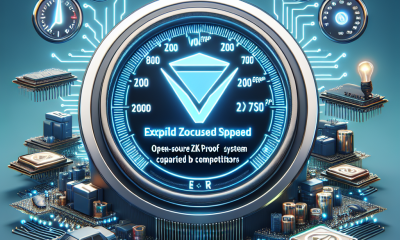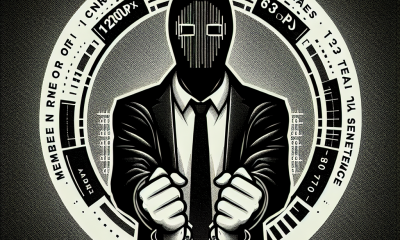Bitcoin
Sen Cynthia Lummis Champions Crypto in Congress, Heralding Pro-Crypto Legislation Wins

In a significant move that underscores the evolving stance of the U.S. Congress toward digital currencies, Senator Cynthia Lummis has made it clear that efforts are underway to cultivate a pro-crypto coalition among lawmakers. These remarks, part of a message posted on X (formerly known as Twitter), have ignited discussions across social media platforms, with many in the crypto community expressing optimism about the potential for more favorable regulations in the future. Senator Lummis’s commitment to building a “pro-crypto army in Congress” is seen as a step forward in the ongoing dialogue between the crypto industry and regulatory authorities.
The crypto industry has long navigated a complex regulatory environment, with companies frequently finding themselves in legal tangles with bodies like the Securities and Exchange Commission (SEC). Senator Lummis’s recent comments follow closely on the heels of several developments that suggest a shift toward a more crypto-friendly regulatory framework. Notably, the U.S. Senate recently overturned the SEC’s SAB 22 mandate, which had imposed stringent regulations on financial institutions wishing to act as crypto custodians. This move was celebrated widely across the crypto space, further fueled by Senator Lummis’s enthusiastic social media posts, including one where she featured “bitcoin laser eyes,” symbolizing a victory for the digital assets community.
This legislative progress was compounded by the significant majority of the House of Representatives voting in favor of the FIT22 legislation, aiming to provide regulatory clarity for the market. This bipartisan effort signifies growing support for the crypto industry within the legislative branch, with both Republican and Democratic representatives showing their backing. Despite the optimism, there remains a palpable concern regarding the potential opposition the bill might face in the Senate, underlining the political hurdles still present in the path toward comprehensive crypto regulation.
Contrastingly, not all lawmakers share this enthusiasm for cryptocurrencies. Senator Elizabeth Warren and others have consistently voiced concerns regarding digital currencies, advocating for stringent regulations to mitigate potential risks, including their use in illegal financial activities. This divergence in opinion within Congress illustrates the ongoing debate over the appropriate level of regulation needed for the burgeoning crypto industry.
The discourse around FIT22 and the broader regulatory landscape for cryptocurrencies in the U.S. is reflective of the larger global conversation on how to balance innovation in the digital assets space with consumer protection and financial stability. As lawmakers like Senator Lummis champion more crypto-friendly policies, industry watchers remain attentive to the responses from both supporters and critics within the Senate. The potential impact of these legislative efforts on the market, including the reaction from crypto firms and investors, underscores the profound implications of policymaking in the digital age.
While enthusiasm from certain sectors of the crypto community is palpable following recent legislative wins, the path forward remains uncertain, with debates likely to continue around the specifics of regulation and oversight. Nonetheless, the formation of a “crypto army” in Congress as proposed by Senator Lummis could mark a pivotal moment in the ongoing journey towards establishing clear, effective, and supportive legislative frameworks for digital currencies in the United States. As the landscape evolves, all eyes will be on how these developments can shape the future of cryptocurrency in the country and, potentially, influence global standards for the digital economy.
Bitcoin
Cardano Community to Govern $681 Million Treasury Amidst Historic Chang Fork Upgrade

The Cardano community stands at the brink of a new era with the impending Chang Fork, transitioning into what is being hailed as the “Age of Voltaire.” This crucial step will thrust upon its members governance over an impressive treasury amassing over $683 million, elevating its status to possess the eighth-largest treasury within the cryptocurrency sphere. The accumulation of these funds, sourced from transaction fees and block rewards, earmarks a significant shift towards self-sustainability and fosters further development within the Cardano ecosystem.
In stark contrast to its contemporaries, Cardano’s treasury is unique, consisting solely of ADA tokens. This sets it apart from the norm observed in other blockchain protocols that diversify their treasury assets across stablecoins and notable cryptocurrencies such as bitcoin and ethereum. This strategic decision reflects Cardano’s commitment to its native token and the vision of its future.
The Cardano project, underpinned by a strategic roadmap, operates through a tripartite governance structure which includes the Cardano Foundation, Input Output Global (IOG), and EMURGO. These entities synergize efforts in development, research, and commercial activities, laying the groundwork for the treasury’s management. The proposed Chang Fork, a significant upgrade, will catalyze the shift towards a decentralized model for the blockchain ecosystem, marking it as an unprecedented milestone in Cardano’s journey and the broader industry.
Charles Hoskinson, the founder of Cardano, encapsulated the significance of this transition, envisioning a decentralized civilization that spans across the globe, powered by a complex governance system. Supported by an annual budget and the collective wisdom of the Cardano community, this evolution promises to introduce a highly advanced framework for blockchain governance. Hoskinson’s ambitions for Cardano extend far beyond technological innovation, fostering a global community bound by shared goals and collective decision-making processes.
The Chang Fork represents the culmination of a long-term vision for Cardano, transitioning control over to its community. This evolution will activate voting and treasury systems, enabling ADA holders to propose and pass resolutions on significant improvements and innovations. By empowering its network participants through an inclusive governance model via staking and delegation, Cardano embarks on achieving a significant degree of self-sustainability. This process not only democratizes innovation within the ecosystem but also ensures that the development trajectory aligns with the community’s aspirations.
Cardano’s roadmap and the Chang Fork initiative highlight the project’s commitment to a decentralized and inclusive model. With a focus on empowering its community members and fostering ecosystem development, Cardano is poised to set new standards in blockchain governance and operational sustainability. As it transitions into the Age of Voltaire, Cardano’s vision of a decentralized civilization seems increasingly attainable, promising a new chapter in the cryptocurrency domain marked by innovation, engagement, and collective progress.
Bitcoin
Bitcoin Value Plummets to $67,900 Triggering Over $100 Million in Market Liquidations Amidst ETF Outflows

In a turn of events that caught many investors off guard, bitcoin‘s valuation took a sharp downturn, touching the mark of $67,900—a plunge exceeding 3.5% from its impressive Monday apex of roughly $71,200. This pronounced drop occurred against the backdrop of a recent shift in the dynamics of Bitcoin exchange-traded funds (ETFs), which saw a reversal to negative cash flows after enjoying a near three-week streak of positivity.
The domain of Bitcoin ETFs, a significant part of cryptocurrency investment vehicles that allow investors to get exposure to Bitcoin without the complexities of direct trading, experienced substantial financial movements. Notably, the Fidelity Wise Origin Bitcoin Fund (FBTC) reported a $3.1 million outflow, while the Invesco Galaxy Bitcoin ETF (BTCO) and the Valkyrie Bitcoin Fund (BRRR) witnessed departures of funds totaling $21 million and $15.9 million respectively. Grayscale Bitcoin Trust (GBTC), a leading player in the field, registered the highest outflow, seeing $40 million drain away from its coffers.
On the flip side, optimism was not completely absent from the market. BlackRock’s iShare Bitcoin Trust (IBTC) succeeded in attracting an inflow of $6.5 million, and the Bitwise Bitcoin Fund (BITB) drew in $7.7 million, suggesting that interest in Bitcoin, despite the setbacks, remains alive and well within certain quarters of the investment community.
Yet, the day concluded with a net outflow of $65.4 million across all Bitcoin ETFs monitored, marking a notable shift in investor sentiment that hadn’t been witnessed since the early days of May. This transformation in the flow of investment funds has not only adjusted the balance sheets of these ETFs but also injected a degree of instability into the market, as evidenced by the staggering $102 million in crypto liquidations recorded over a mere 12-hour window. This tumult resulted predominantly from long position closures, which accounted for $95.4 million, while shorts contributed to liquidations amounting to about $6.6 million.
Despite this volatility, notable figures within the finance domain maintain a bullish stance on Bitcoin’s long-term prospects. Among them is Robert Kiyosaki, the acclaimed author of “Rich Dad Poor Dad,” who champions Bitcoin as an effortless wealth-building tool. Kiyosaki’s endorsement underlines a sentiment of resilience and belief in the cryptocurrency’s capacity to serve as a revolutionary financial instrument, despite its susceptibility to fluctuating market forces.
This situation mirrors the broader cryptocurrency environment, marked by its inherent volatility but also characterized by a persistent allure that continues to captivate investors—both seasoned veterans and newcomers. As the landscape evolves, the market’s reaction to these recent ETF outflows and the consequential price adjustments of Bitcoin will be closely monitored. The current scenario underscores the delicate balance between optimism and caution that defines the crypto investment sphere. Nonetheless, the enduring appeal of cryptocurrencies, particularly Bitcoin, as a decentralized and potentially lucrative asset class, continues to draw interest and speculation about its future direction.
Bitcoin
Revolution in Investment: Real-World Asset Tokenization Sector Surges Ahead of Ethereum and Bitcoin

In a remarkable surge within the cryptocurrency sector, the tokenization of real-world assets (RWA) has prominently emerged as the leader, eclipsing the performance of giants such as ethereum (eth) and bitcoin (btc). This ascendancy is powered by high-profile asset tokenizations and a positive regulatory landscape, showcasing the sector’s burgeoning potential and growing significance in the financial industry.
The sector’s remarkable performance is partly attributable to significant strides in high-profile use cases and regulatory advancements. For instance, on June 4, Galaxy Digital executed a multimillion-dollar loan secured by a 316-year-old Stradivarius violin, using its digital representation as a non-fungible token (NFT) for collateral. This innovative use case not only ensured strong security for Galaxy Digital but also illustrated the flexibility and potential of asset management through tokenization. The physical violin, secured and monitored under strict conditions in Hong Kong, demonstrates a tangible bridge between traditional assets and digital futures.
On the same note, Watford Football Club ventured into digital equity, offering approximately 11% of its shares in collaboration with digital investment platforms Republic and Seedrs. Such initiatives not only bring traditional assets into the digital ecosystem but also open new avenues for investment and ownership democratization.
Regulatory developments have also shown support for the burgeoning sector. A pivotal hearing titled “Next Generation Infrastructure: How Tokenization of Real-World Assets Will Facilitate Efficient Markets” was held on June 7 by the US Financial Services Committee. This forum brought together a diverse group of industry leaders and experts, ranging from Carlos Domingo, Co-founder and CEO of Securitize, to representatives from the financial markets sector and academia. Their discussions underscored the ongoing debate surrounding blockchain technology’s integration into traditional finance, indicating a move towards regulatory clarity and broader adoption of tokenization technologies.
The sentiment within the sector remains optimistic for the long-term. Prominent figures like BlackRock CEO Larry Fink have voiced their confidence in tokenization, emphasizing its potential to revolutionize investment strategies through instantaneous bond and stock settlements, thus significantly reducing settlement costs. Similarly, Jenny Johnson, CEO of Franklin Templeton, pointed out the transformative capability of RWA tokenization, from offering NFT-based Rihanna royalties to integrating loyalty programs with tangible assets. This perspective aligns with Johnson’s view on leveraging technology to merge traditional assets with blockchain, enhancing accessibility for younger investors and promoting a culture of saving and investment through digital wallets.
The embracing of RWA tokenization by traditional financial institutions is seen as a pivotal movement towards democratizing investment opportunities and fostering financial inclusion. Johnson’s insights highlight how reduced entry points and operational costs associated with tokenized assets could encourage more inclusive savings and investment practices, particularly among younger demographics. As traditional and digital financial realms converge, RWA tokenization stands as a beacon for the future of finance, weaving together technological innovation with the fabric of conventional asset management to pave the way for a more accessible and efficient financial ecosystem.
In essence, the rise of RWA tokenization not only exemplifies the dynamic and evolving nature of the cryptocurrency sector but also signals a broader trend towards integrating blockchain technology into mainstream financial practices. This integration promises to revolutionize asset management and investment, offering a more inclusive, efficient, and secure platform for investors and stakeholders across the globe.
-

 Cryptocurrency1 month ago
Cryptocurrency1 month agoExploring the Future of Finance: Regulated Settlement Network PoC Aims to Unify Banking and Securities on a Single Platform
-

 Cryptocurrency1 month ago
Cryptocurrency1 month agoProtocol Village Announces ‘Expander’: An Open-Source ZK Proof System Doubling Speed Compared to Competitors
-

 Cryptocurrency2 months ago
Cryptocurrency2 months agoDr. Ted Kaouk Named Inaugural Chief AI Officer by CFTC
-

 Altcoins2 months ago
Altcoins2 months agoForecasting the Future of Shiba Inu (SHIB) Prices: Heading for a Rally or a Downturn?
-

 Cryptocurrency1 month ago
Cryptocurrency1 month agoOpenAI Gears Up for Exciting ChatGPT Update: New Features and Potential Pricing Changes on the Horizon
-

 Memecoins2 months ago
Memecoins2 months agoTop Cryptocurrencies Poised for Growth in 2024
-

 Cryptocurrency2 months ago
Cryptocurrency2 months agoFederal Reserve Maintains Current Policy, Notes Stagnation in Inflation Progress
-

 Cryptocurrency2 months ago
Cryptocurrency2 months agoMember of REvil Ransomware Syndicate, Rabotnik, Receives 13-Year Jail Sentence



